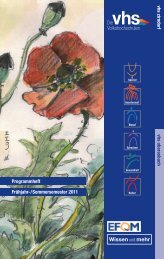Der NEUE Katalog ist da! - PRO PUBLIC GmbH
Der NEUE Katalog ist da! - PRO PUBLIC GmbH
Der NEUE Katalog ist da! - PRO PUBLIC GmbH
Create successful ePaper yourself
Turn your PDF publications into a flip-book with our unique Google optimized e-Paper software.
1<br />
Serum-free Systems<br />
Basics:<br />
Cell culture, the cultivation of cells isolated from live tissue<br />
in vitro (in the test tube), is an acknowledged and valuable<br />
tool in the biomedical research for the determination of<br />
reproducible <strong>da</strong>ta. Apart from that, by means of cell cultures<br />
more and more highly effective substances are produced<br />
in large-scale for medicine and research (e.g. Insulin,<br />
Growth Factors, Monoclonal Antibodies or Clotting Factors).<br />
The Cell Culture with Serum:<br />
Cells in vitro need nutrient solutions, so-called media which<br />
guarantee an imitation as exact as possible of the situation<br />
in vivo (in live organism). On the other hand these media<br />
– mixtures of nutrients, salts, trace elements, buffer substances,<br />
growth factors, protective substances and many<br />
other components – must be complemented for this purpose<br />
by the most natural, highly complex additives. Not<br />
long ago animal but also human serum were the means<br />
to be chosen for reasons of production technology and<br />
also because of a lack of alternatives.<br />
Function of Serum in the Cell Culture:<br />
• Hormone factors stimulate cell growth, proliferation<br />
and differentiation.<br />
• Attachment factors favour or enable the attachment<br />
of the cells to the culture dish (Biomatrix).<br />
• Transport and binding proteins take care among other<br />
things of the supply of hormones, minerals and lipids.<br />
• Serum proteins bind toxic substances.<br />
This serum, mostly fetal bovine serum (FCS), is problematic<br />
for several reasons.<br />
Disadvantages of Serum in the Cell Culture:<br />
• The composition of serum is not constant and varies<br />
with the age of the foetus, with the origin and feeding<br />
of the animals and with the time of the year.<br />
• Serum batches have to be tested for their suitability<br />
before use.<br />
• Test results are often not convincing and often not<br />
comparable because of the undefined and inconstant<br />
composition of the serum.<br />
• Risk of a contamination with bacteria, fungi, mycoplasm<br />
and virus from serum.<br />
• Risk of a contamination with TSE-agents (transmissible<br />
spongiform encephalopathy).<br />
• Possibility of a contamination of the end product with<br />
serum proteins or pyrogens.<br />
• Time-consuming cleaning of the end products from culture<br />
media containing serum.<br />
• Availability and costs of the serum.<br />
Introduction/Einführung<br />
1.1<br />
Serum-freie Systeme<br />
Grundlagen:<br />
Die Zellkultur – d.h. die Kultivierung von aus lebenden Geweben<br />
isolierten Zellen in vitro (im Reagenz-Glas) – <strong>ist</strong> ein<br />
anerkanntes, wertvolles Werkzeug der biomedizinischen<br />
Forschung zur Gewinnung reproduzierbarer Daten. Daneben<br />
bietet es mögliche Ansätze für den Einsatz als Ersatzund<br />
Ergänzungsmethode zum herkömmlichen Tierversuch.<br />
In neuerer Zeit werden mit Hilfe von Zellkulturen immer<br />
mehr hochwirksame Stoffe im großen Maßstab für Medizin<br />
und Forschung hergestellt (Insulin, Wachstumsfaktoren,<br />
Impfstoffe, monoklonale Antikörper, Blutgerinnungsfaktoren<br />
u.s.w.).<br />
Die Zellkultur mit Serum:<br />
Zellen in vitro benötigen zum Wachstum Nährlösungen,<br />
so genannte Medien, die eine möglichst exakte Nachahmung<br />
der Situation in vivo (im lebenden Organismus) gewährle<strong>ist</strong>en.<br />
Diese Medien-Mischungen von Nährstoffen,<br />
Aminosäuren, Vitamine, Salzen, Spurenelementen, Puffersubstanzen,<br />
Wachstumsfaktoren, Schutzstoffen und vielen<br />
anderen Komponenten müssen für ein funktionsfähiges<br />
Zellkulturmedium mit me<strong>ist</strong> natürlichen, hochkomplexen<br />
Zusätzen ergänzt werden. Tierische, aber auch humane<br />
Seren waren bis vor kurzem aus produktionstechnischen<br />
Gründen sowie mangels Alternativen <strong>da</strong>s Mittel der Wahl.<br />
Funktion von Serum in der Zellkultur:<br />
• Hormonelle Faktoren stimulieren Proliferation und Differenzierung<br />
der Zellen.<br />
• Adhäsionsfaktoren begünstigen oder ermöglichen die<br />
Anheftung der Zellen an die Kulturgefäße (Biomatrix).<br />
• Transport- und Bindungsproteine sorgen unter anderem<br />
für die Bereitstellung von Hormonen, Mineralien und<br />
Lipiden.<br />
• Serumproteine binden toxische Stoffe.<br />
Diese Seren, me<strong>ist</strong> fötales Rinderserum (FCS), sind aber<br />
aus unterschiedlichsten Gründen problematisch.<br />
Nachteile von Serum in der Zellkultur:<br />
• Die Zusammensetzung von Serum <strong>ist</strong> nicht konstant<br />
und variiert mit dem Alter der Föten, mit der Herkunft<br />
und Fütterung der Tiere und je nach Jahreszeit.<br />
• Die Serumchargen müssen vor dem Einsatz auf ihre<br />
Eignung getestet werden.<br />
• Versuchsergebnisse sind durch die nicht definierte<br />
und nicht konstante Zusammensetzung der Seren oft<br />
nicht aussagekräftig und oft nicht vergleichbar.<br />
• Einige Serumbestandteile (z. B. Hydrocortison) können<br />
auf bestimmte Zellen zytostatisch wirken (Glia-Zellen,<br />
Lungenepithelzellen).<br />
• Es besteht <strong>da</strong>s Risiko einer Kontamination der Zellkultur<br />
durch Bakterien, Pilze, Mycoplasmen oder Viren aus<br />
dem Serum.<br />
• Durch <strong>da</strong>s Serum können Kontaminationen mit TSE-<br />
Agenzien (Transmissible Spongioform Encephalopathy)<br />
nicht vollständig ausgeschlossen werden.<br />
• Es besteht <strong>da</strong>s Risiko einer Verunreinigung des Endproduktes<br />
mit Serumproteinen oder Pyrogenen.<br />
• Aus serumhaltigen Kulturen sind die Endprodukte<br />
schwieriger und technisch aufwendiger aufzureinigen.<br />
• Seren sind nicht immer in ausreichender Menge und<br />
Qualität verfügbar und zudem teuer.<br />
BIOTECH <strong>GmbH</strong>





